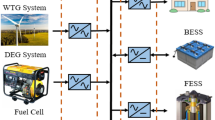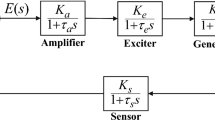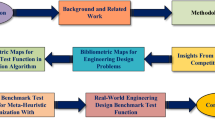Abstract
This study presents the design of a tenth-order multiple feedback Chebyshev low-pass filter (MF-C-LPF). Component selection and gain calculation of filters are generally achieved over long periods of time using traditional methods. For 1-dB and 3-dB gains, the component values of the filter were optimized for both continuous and discrete values using four different metaheuristic algorithms. In the first case where continuous values were used, component values were accepted as ideal and unlimited in order to minimize gains. In the second case, industrial E196 series component values were used to transform the design problem into a discrete optimization problem. In this case where the design problem became more complex, the performance of the metaheuristic algorithms was compared. The literature review shows that this study is the first attempt to design a 10th-order MF-C-LPF for E196 series values. The average differential evolution algorithm is proposed to determine the optimal component values of the tenth-order MF-C-LPF. The performance of the proposed method was compared with three commonly used algorithms (PSO, CSS and DE). The optimal filter component values and quality factors (Q) were presented for each stage. We believe that the quality factor values will be a reference for future studies.


















Similar content being viewed by others
References
Lacanette K (2010) A basic introduction to filters: active, passive, and switched-capacitor. Texas Instruments National Semiconductor Application Note. http://www.ti.com/lit/an/snoa224a/snoa224a.pdf. Accessed 4 May 2019
Schaumann R, Van Valkengurg ME (2010) Design of analog filters. Oxford University Press, Oxford
Tseng CC, Lee SL (2017) Closed-form designs of digital fractional order Butterworth filters using discrete transforms. Signal Process 137:80–97. https://doi.org/10.1016/j.sigpro.2017.01.015
Yao SN, Collins T, Jancovic P (2012) Hybrid method for designing digital Butterworth filters. Comput Electr Eng 38(4):811–818. https://doi.org/10.1016/j.compeleceng.2012.03.015
Thammawongsa N, Phromloungsri R, Jamsai M, Pornsuwancharoen N (2012) Design elliptic low pass filter with inductively compensated parallel-coupled lines. Procedia Eng 32:550–555. https://doi.org/10.1016/j.proeng.2012.01.1307
Ding S, Bian W, Sun T, Xue Y (2017) Fingerprint enhancement rooted in the spectra diffusion by the aid of the 2D adaptive Chebyshev band-pass filter with orientation-selective. Inf Sci 415–416:233–246. https://doi.org/10.1016/j.ins.2017.06.028
Karam LJ, McClellan JH (1999) Chebyshev digital FIR filter design. Signal Process 76(1):17–36. https://doi.org/10.1016/S0165-1684(98)00244-8
Vaezi A, Gharaklili FG (2018) Synthesis and design of an LPF with wide-stop band and high rejection level. AEU Int J Electron Commun 95:139–145. https://doi.org/10.1016/j.aeue.2018.08.010
Goh C, Li Y (2001) GA automated design and synthesis of analog circuits with practical constraints. In: Proceedings of the congress on evolutionary computation, pp 170–177
Vural RA, Yildirim T, Kadioglu T, Basargan A (2012) Performance evaluation of evolutionary algorithms for optimal filter design. IEEE Trans Evol Comput 16(1):135–147. https://doi.org/10.1109/TEVC.2011.2112664
Gholami-Boroujeny S, Eshghi M (2012) Non-linear active noise cancellation using a bacterial foraging optimisation algorithm. IET Signal Proc 6(4):364–373. https://doi.org/10.1049/iet-spr.2011.0092
De BP, Kar R, Mandal D, Ghoshal SP (2015) Optimal selection of components value for analog active filter design using simplex particle swarm optimization. Int J Mach Learn Cyber 6(4):621–636. https://doi.org/10.1007/s13042-014-0299-0
Doğan B, Ölmez T (2015) Vortex search algorithm for the analog active filter component selection problem. AEU Int J Electron Commun 69(9):1243–1253. https://doi.org/10.1016/j.aeue.2015.05.005
Reja AH, Al-Salih AAM, Ahmad SN (2017) A matematerialized design for 7th order type-I Chebyshev LPF. Mater Today Proc 4:10383–10389
Bose D, Biswas S, Vasilakos AV, Laha S (2014) Optimal filter design using an improved artificial bee colony algorithm. Inf Sci 281:443–461. https://doi.org/10.1016/j.ins.2014.05.033
Prommee P, Thongdit P, Angkeaw K (2017) Log-domain high-order low-pass and band-pass filters. AEU Int J Electron Commun 79:234–242. https://doi.org/10.1016/j.aeue.2017.06.014
Bulut GG, Güler H, Özdemir MT (2017) Optimal selection of components in a sixth-order Butterworth low-pass filter with using grey wolf algorithm. Int J Electr Electron Data Commun 5(10):1–4
Nayak B, Choudhury TR, Misra B (2018) Component value selection for active filters based on minimization of GSP and E12 compatible using Grey Wolf and Particle Swarm Optimization. AEU Int J Electron Commun 87:48–53. https://doi.org/10.1016/j.aeue.2018.02.005
Hiçdurmaz B, Durmuş B, Temurtaş H, Özyön S (2016) The prediction of butterworth type active filter parameters in low pass sallen key topology by backtracking search algorithm. In: Proceedings of 2nd international conference on engineering and natural sciences, vol. 9, pp 2422–2428
Durmuş B, Hiçdurmaz B, Temurtaş H, Özyön S (2016) Defining the parameters of the high pass active filter by using backtracking search algorithm. In: Proceedings of 2nd international conference on engineering and natural sciences, vol. 9, pp 2429–2435
Horrocks DH, Spittle MC (1993) Component value selection for active filters using genetic algorithms. Proc IEEE Workshop Natl Algorithms Signal Process 1(13):1–6
Kalinli A (2006) Component value selection for active filters using parallel tabu search algorithm. AEU Int J Electron Commun 60(1):85–92. https://doi.org/10.1016/j.aeue.2005.03.001
Vural RA, Bozkurt U, Yildirim T (2013) Analog active filter component selection with nature inspired metaheuristics. AEU Int J Electron Commun 67(3):197–205. https://doi.org/10.1016/j.aeue.2012.07.009
Durmuş B (2018) Optimal components selection for active filter design with average differential evolution algorithm. AEU Int J Electron Commun 94:293–302. https://doi.org/10.1016/j.aeue.2018.07.021
Jiang M, Yang Z, Gan Z (2007) Optimal components selection for analog active filters using clonal selection algorithm. In: Proceedings of international conference on intelligent computing, pp 950–959
Pactitis SA (2007) Active filters theory and design. CRC Press Taylor & Francis Group, Broken
Sallen RP, Key EL (1955) A practical method of designing RC active filters. IRE Trans Circuit Theory 2(1):74–85. https://doi.org/10.1109/TCT.1955.6500159
Karki J (2002) Active low-pass filter design, Texas Instruments Application Report. http://www.ti.com/lit/an/sloa049b/sloa049b.pdf. Accessed 05 May 2019
Kaveh A, Talatahari S (2010) A novel heuristic optimization method: charged system search. Acta Mech 213(3–4):267–289. https://doi.org/10.1007/s00707-009-0270-4
Storn R, Price K (1997) Differential evolution—a simple and efficient heuristic for global optimization over continuous spaces. J Global Optim 11(4):341–359. https://doi.org/10.1023/A:1008202821328
Kennedy J, Eberhart RC (1995) Particle swarm optimization. Proc IEEE Int Conf Neural Netw 4:1942–1948
Kamboj VK, Bath SK, Dhillon JS (2016) Solution of non-convex load dispatch problem using grey wolf optimizer. Neural Comput Appl 27:1301–1316. https://doi.org/10.1007/s00521-015-1934-8
Bala R, Ghosh S (2019) Optimal position and rating of DG in distribution networks by ABC-CS from load flow solutions illustrated by fuzzy-PSO. Neural Comput Appl 31:489–507. https://doi.org/10.1007/s00521-017-3084-7
Cheng MY, Prayogo D (2017) A novel fuzzy adaptive teaching-learning-based optimization (FATLBO) for solving structural optimization problems. Eng Comput 33:55–69. https://doi.org/10.1007/s00366-016-0456-z
Author information
Authors and Affiliations
Corresponding author
Ethics declarations
Conflict of interest
The authors declare that they have no conflict of interest.
Human and animals rights
No experiments were performed that involved humans/animals.
Informed consent
No human participant-based experiments were performed so it is not needed.
Additional information
Publisher's Note
Springer Nature remains neutral with regard to jurisdictional claims in published maps and institutional affiliations.
Appendix
Appendix
Rights and permissions
About this article
Cite this article
Durmuş, B., Temurtaş, H. & Özyön, S. The design of multiple feedback topology Chebyshev low-pass active filter with average differential evolution algorithm. Neural Comput & Applic 32, 17097–17113 (2020). https://doi.org/10.1007/s00521-020-04922-7
Received:
Accepted:
Published:
Issue Date:
DOI: https://doi.org/10.1007/s00521-020-04922-7




